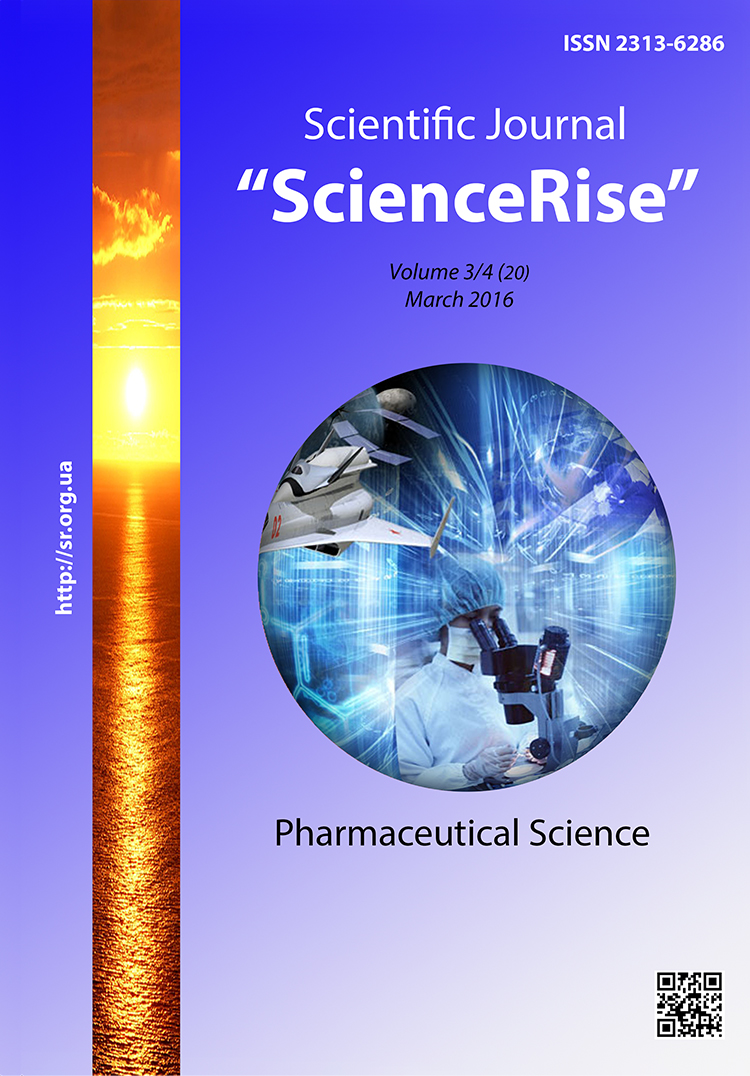Synthesis of the row of new functional derivatives of 7-arylalkyl-8-hydrazine theophyllines
DOI :
https://doi.org/10.15587/2313-8416.2016.65209Mots-clés :
synthesis, 7, 8-disubstituted of 1, 3-dimethylxantine, hydrazine derivatives, spectral analysis methodsRésumé
Hydrazine functional derivatives are widely used in medical practice as remedies applied for pharmacotherapy of depression, infection diseases, hypertension, diabetes, etc. It is worth mentioning that among obtained 7-R-8-hydrazine derivatives of 1,3-dimethylxantine promising substances have been identified. Due to the fact that literature sources display only results of occasional studies of the reactions between 7-R-8-hydrazine theophyllines and mono- or dicarbonyle substances, the use of other keto reagents for xanthine bicycle at 8th position functionalization will allow to explore synthetic potential of the last one, and with high probability may lead to obtaining original biologically active substances.
Aim. To study types of reaction between 8-hydrazinyl-1,3-dimethyl-7-aryl alkyl-1H-purine-2,6(3H,7H)-diones and a number of carbonyl containing reagents.
Methods. A nucleophilic addition reaction followed by dehydration or ethanol splitting was used, as well as the complex of the modern analysis methods to confirm the structure and individuality of the synthesized substances.
Results. Different directions of 8-hydrazinyl-1,3,-dimethyl-7(fenetyl-, 3-phenylpropyl-, 3-phenylalyl)-1H-purine-2,6(3H,7H)-diones chemical transformations in reactions with the appropriate carbonyl containing compounds have been studied experimentally. The structure of synthesized substances was confirmed by chromatography/mass and 1H NMR spectroscopy.
Conclusion. The group of 7-arylalkyl-8-(3,5-R,R1-pyrazole-1-yl)theophyllines, consisting of two functionally substituted bioactive heterocycles, has been synthesized by reaction between initial substances and selected mono- and dicarbonyl compounds
Références
Zelenin, K. N. (1998). Gidrazin. Sorosovskij obrazovatel'nyj zhurnal, 5, 59–65.
Mashkovskij, M. D. (2012). Lekarstvennye sredstva. 16th edition. Moscow: Novaja volna, 1216.
Sweetman, S. C. (Ed.) (2009). Martindale: The Complete Drug Reference. Thirty-sixth edition. Pharmaceutical Press, 3694.
Rollas, S., Küçükgüzel, S. G. (2007). Biological Activities of Hydrazone Derivatives. Molecules, 12 (8), 1910–1939. doi: 10.3390/12081910
Narang, R., Narasimhan, B., Sharma, S. (2012). A Review on Biological Activities and Chemical Synthesis of Hydrazide Derivatives. Current Medicinal Chemistry, 19 (4), 569–612. doi: 10.2174/092986712798918789
Mosselhi, M. A. N., Tawfik, N. M., Shawali, A. S. (2003). New [ e ]-Fused Caffeines: A Simple Synthesis of 3-Substituted [1,2,4]Triazolo[4,3- e ]purines. Monatshefte Fur Chemie/Chemical Monthly, 134 (4), 565–571. doi: 10.1007/s00706-002-0514-7
Petch, D., Anderson, R. J., Cunningham, A., George, S. E., Hibbs, D. E., Liu, R. et. al. (2012). Design and synthesis of EGFR dimerization inhibitors and evaluation of their potential in the treatment of psoriasis. Bioorganic & Medicinal Chemistry, 20 (19), 5901–5914. doi: 10.1016/j.bmc.2012.07.048
Ashour, F. A., Rida, S. M., El-Hawash, S. A. M., ElSemary, M. M., Badr, M. H. (2011). Synthesis, anticancer, anti-HIV-1, and antimicrobial activity of some tricyclic triazino and triazolo[4,3-e]purine derivatives. Medicinal Chemistry Research, 21 (7), 1107–1119. doi: 10.1007/s00044-011-9612-6
Korobko, D. B., Berezovs'kyj, O. V., Palagnjuk, M. M., Pylypiv, Je. S. (2011). Syntez i fizyko-himichni vlastyvosti dejakyh 7-aralkil-(alkenil)-8-bromo-(tio-)teofiliniv. Liky – ljudyni. Harkiv, 263–269.
Abdel-Wahab, B. F., Abdel-Gawad, H., Mohamed, H. A., Dawood, K. M. (2010). Utility of 2,4-Dioxoesters in the Synthesis of New Heterocycles. HETEROCYCLES, 81 (1), 1–55. doi: 10.3987/rev-09-659
Gumennoj, V. P. (1984). Kondensacija 1,3-dikarbonil'nyh soedinenij s 8-gidrazinoksantinami. Chem. Abstrac., 101 (13), 110869.
Povstjanoj, M. V., Kruglenko, V. P., Kljuev, N. A. et. al. (1992). Kondensirovannye imidazo-1,2,4-aziny. XXVI. O reakcii 8-gidrazinoksantina i 8-(1-metilgidrazino)teofillina s acetil- i benzoilacetonom. Zhurnal org. himii, 28 (4), 849–856.
Voskobojnik, O. Ju. (2008). Syntez, peretvorennja, fizyko-himichni ta biologichni vlastyvosti [{2-R-(3H)-[hinazolin-4-iliden}gidrazono]karbonovyh kyslot. L'viv. nac. med. un-t imeni Danyla Galyc'kogo, 26.
Tarasevich, B. N. (2012). IK spektry osnovnyh klassov organicheskih soedinenij. Spravochnye materialy. Moscow: MGU, 55.
Silverstein, R. M., Webster, F. X., Kiemle, D. J. (2005). Spectrometric identification of organic compounds. 7 edition. John Wiley & Sons Ltd, USA, 267.
Téléchargements
Publié-e
Numéro
Rubrique
Licence
(c) Tous droits réservés Dmytro Korobko 2016

Cette œuvre est sous licence Creative Commons Attribution 4.0 International.
Our journal abides by the Creative Commons CC BY copyright rights and permissions for open access journals.
Authors, who are published in this journal, agree to the following conditions:
1. The authors reserve the right to authorship of the work and pass the first publication right of this work to the journal under the terms of a Creative Commons CC BY, which allows others to freely distribute the published research with the obligatory reference to the authors of the original work and the first publication of the work in this journal.
2. The authors have the right to conclude separate supplement agreements that relate to non-exclusive work distribution in the form in which it has been published by the journal (for example, to upload the work to the online storage of the journal or publish it as part of a monograph), provided that the reference to the first publication of the work in this journal is included.

